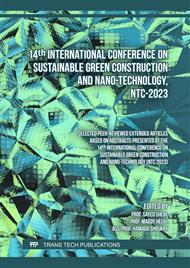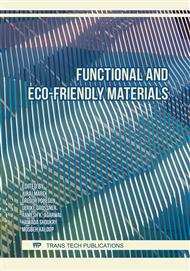[1]
Ahmed Hamdi Mansi, Osama Hussein Galal, and Mutlaq Lafi, "The utilization of lathe steel waste fibers to improve plain concrete", International Journal of Civil and Structural Engineering – IJCSE, Volume 6: Issue 2, Dec 2019, pp.25-28.
Google Scholar
[2]
Akshaya T., Manikandan G., Esther Baby J., Jaambavi I., "Experimental study on bending behaviour of fiber reinforced concrete by using lathe waste fiber", Materials Today: Proceedings, Vol.21, April 2021.
DOI: 10.1016/j.matpr.2021.03.324
Google Scholar
[3]
Pavan Prasad B., Sai Maanvit P., Durga Chaitanya Kumar Jagarapu, Arunakanthi Eluru, "Flexural behavior of fiber reinforced concrete incorporation with lathe steel scrap", Volume 33, Part 1, 2020, pp.196-200.
DOI: 10.1016/j.matpr.2020.03.793
Google Scholar
[4]
Abimbola Rasheed Ogungbire, Michael Oluwadare Adeyinka, Olawale S.O.A., Lily Chimuanya, Olumuyiwa O. Onakunle, David. O. Omole, "Investigation of the compressive, split tensile and flexural characteristics of steel scrap composite concrete", International Journal of Civil Engineering and Technology (IJCIET), Volume 9, Issue 9, September 2018, p.894–901.
Google Scholar
[5]
Marcin Małek, Marta Kadela, Michał Terpiłowski, Tomasz Szewczyk, Waldemar Łasica, and Paweł Muzolf, "Effect of Metal Lathe Waste Addition on the Mechanical and Thermal Properties of Concrete", Materials journal, Volume 14, pp.2760-2759, 2021.
DOI: 10.3390/ma14112760
Google Scholar
[6]
Hasan Jasim Mohamed, Abbas Hadi Abbas, Muhammed Abbas Husain, "Using of recycled rubber tires and steel lathes waste as fibbers to reinforcing concrete", Iraqi Journal of civil engineering, Vol. 9(1), pp.27-38, 2011.
DOI: 10.37650/ijce.2013.80363
Google Scholar
[7]
Mohammed Seddik Meddah, Mohamed Bencheikh, "Properties of concrete reinforced with different kinds of industrial waste fibre materials", Construction and Building Materials journal, Vol. 23, July, 2009, p.3196–3205.
DOI: 10.1016/j.conbuildmat.2009.06.017
Google Scholar
[8]
Vijayakumar G., Senthilnathan P., Pandurangan K., and Ramakrishna G., "Impact and energy absorption characteristics of lathe scrap reinforced concrete", Vol. 1, No. 1, November 2012, pp.60-66.
Google Scholar
[9]
Abbas Hadi Abbas, "Management of Steel Solid Waste Generated from Lathes as Fiber Reinforced Concrete", European Journal of Scientific Research, Vol.50, No.4, 2011, pp.481-485.
Google Scholar
[10]
Gawatre, D.W., Haldkar, P., Nanaware, S., Salunke, A., Shaikh, M., Patil, "Study on addition of lathe scrap to improve the mechanical properties of concrete", International Journal Innovate Research Science Engineering Technology, Volume 5, 2016, p.8573–8578.
Google Scholar
[11]
Mohamed S. Moawad, "Effect of short glass fiber on shear capacity for shallow wide reinforced concrete beams", Journal of Engineering and Applied Science, 2021.
DOI: 10.1186/s44147-021-00051-7
Google Scholar
[12]
EN 12390-3, 2001 Testing hardened Concrete-Part3: Compressive Strength of Test Specimens, December.
Google Scholar
[13]
BS EN 12390-6:2009, Testing hardened Concrete-Part6: Tensile Splitting Strength of Test Specimens.
DOI: 10.3403/02128962
Google Scholar
[14]
BS EN 1992 (2004) Design of concrete structures. In: Part 1-1: general rules and rules for buildings. European Committee for Standardization (CEN), Euro code 2, Brussels.
Google Scholar
[15]
ACI 318 (2014) Building code requirements for structural concrete and commentary. American Concrete Institute (ACI), Farmington Hills, MI 3.
DOI: 10.1016/0262-5075(85)90031-4
Google Scholar
[16]
ECP-203-2018 (2018) Egyptian code of practice for design and construction of reinforced concrete structures, Fourth Edition. Reinforced Concrete Structures Research Institute, Housing and Building National Research Center, Giza, Egypt.
Google Scholar
[17]
Youjiang Wang, H. C. Wu, and Victor C. Li, "Concrete reinforcement with recycled fibers", Journal of Materials in Civil Engineering, Volume 12, Issue 4, March 2017, pp.314-319.
Google Scholar



